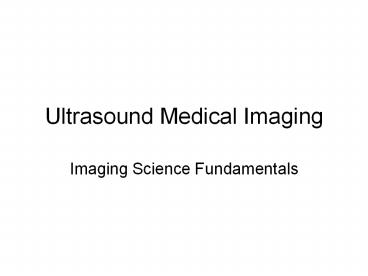Ultrasound Medical Imaging - PowerPoint PPT Presentation
Title:
Ultrasound Medical Imaging
Description:
Ultrasound Medical Imaging Imaging Science Fundamentals Sound waves Sound waves are mechanical waves. Not in electromagnetic spectrum! Just like light waves, sound ... – PowerPoint PPT presentation
Number of Views:164
Avg rating:3.0/5.0
Title: Ultrasound Medical Imaging
1
Ultrasound Medical Imaging
- Imaging Science Fundamentals
2
Sound waves
- Sound waves are mechanical waves. Not in
electromagnetic spectrum! - Just like light waves, sound waves transmit
energy, and can be described in terms of
wavelength, period, speed, and amplitude - Also can be described in terms of pressure,
density, particle displacement
3
Sound waves (2)
- Frequency, period, and amplitude are determined
by the source - Wave speed and changes in density, pressure, and
particle displacement are determined by the
medium - Wavelength depends on both source and medium
4
Some relationships
The higher the frequency, the shorter the period.
Units 1/s The higher the frequency, the
shorter the wavelength. Units m
Note Propagation speed depends on the density
and stiffness of the medium
5
- Human hearing range 20 Hz to 20KHz.
- Sound requires a medium in which to travel. In
the following diagram assume particles are
separated by springs.
When a particle is pushed, the disturbance is
transmitted to the others by springs.
6
- Driving force may be sinusoidal ? particles
oscillate back and forth
pressure
time
Period
7
Sound and Human Hearing
Fast-rate changes (oscillations) in air pressure
arriving at ear are detected by eardrum and
transmitted to the brain, where they are
interpreted as sounds.
8
Ultrasound
- Ultrasound is any sound emitted at a frequency gt
20 KHz. - Medical ultrasound uses freqencies in the MHz
range - Sound speed in tissue c ? 1540 m/s
- similar to speed of sound in water
- need to know c, because it is used to generate
image - In lungs, because of gas, propagation speed is
lower. In bone, because its a solid, propagation
speed is higher. - Ultrasound doesnt penetrate lungs bone very
well
9
- What kinds of waves are used in imaging?
- Pulsed ultrasound. A few cycles of ultrasound
- Produced by applying electric pulses to
transducer
Pulse duration
Pulse repetition period
10
- Imaging with ultrasound
- Sound wave is altered by tissue through which it
passes. - At boundaries between structures (e.g., different
tissue types) it is partially reflected - To determine distance, we need to know
propagation speed pulse round-trip time (from
signal emission to echo detection) then
determines distance - c 2d/t gt d (tc)/2
11
- As round-trip increases, reflectors distance
increases as well - For c 1540 m/s 1.54 mm/ms
130 ms
39 ms
13 ms
cm
0 1 2 3 4 5 6 7 8
9 10
12
- Imaging with ultrasound
- Ultrasound pulse simultaneously encounters
several scatterers ? several echoes are generated
simultaneously
Interference
13
- Imaging with ultrasound
- Interference produces a dotted pattern
(speckles) - does not directly represent echoes, but rather
how they recombine at the detector































